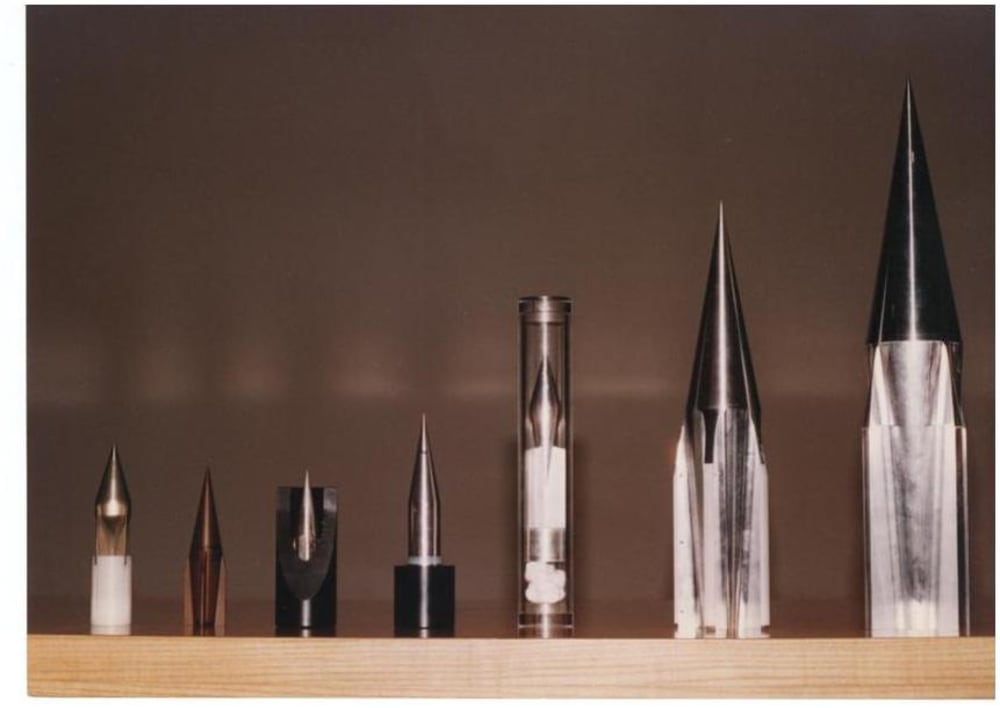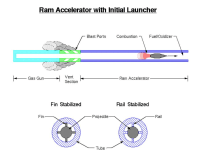The Ram Accelerator, invented in 1983 at the University of Washington, is a novel mass driver consisting of a long straight tube filled with combustible gaseous mixtures such as hydrogen and oxygen. Upon ignition, an aeroshell “surfs the combustion wave” with sufficient velocity to exit the atmosphere. At velocities of ~3km/sec to 8km/sec, (1.86 to 4.97 miles per second), payloads are deployed into Low Earth Orbit Networks within minutes.
Increasing tube size yields proportionate payload and fuel. In gun type devices the energy source is concentrated at the breech while the Ram Accelerator’s distinguishing characteristic is its energy source, always released at the base of the projectile, is uniformly distributed throughout the entire length of the launch tube resulting in minimal barrel erosion, muzzle blast and recoil.
Small payloads pose no threat to people or facilities upon reentry. The G forces are well within the tolerances of off-the-shelf technology. Minimal propellant is carried aboard the projectile. Small reaction control systems on payloads insert the satellites into their desired orbits.
Cost reduction by a full magnitude is now achieved for “shooting stuff into space” as compared to current rocket motor technologies. The Ram Accelerator does not require the traditional 90% weight factor from carrying fuel along to burn and reach orbits as in other systems. A key consideration is no toxic chemical pollution release in our upper atmosphere and the FAA has given tentative approval to launch. As an Extra Class Amateur Radio Operator, I may launch satellites.
Cost-per-mission actually decreases as payload launching quantities increase since the Ram Accelerator Tube is reusable. The refresh firing rate between payloads launching is measured in minutes as required to fulfill launch-on-demand and may also be truck transportable for non-permanent set up in remote locations as Alaska.
1) Inject Picosatellites “POP CAN Launcher” into Low Earth Orbits; CubeSats, SmallSats, PhoneSats, Kicksats, PocketCubes, NanoSats, PongSats, MicroSats, AMSATs
Provide Sat Programs practical cost effective launching solutions
Remove space debris, protect ISS, (International Space Station) and satellites
Launch-On-Demand Local Theater requirements for C4ISR missions:
2) Inject Nanosatellites “MINI-ME Launcher” into Low Earth Orbits
Deploy invisible World Wide Wireless Web Network by 2020
Provide Asteroid Mining/Exploration Robotic Tool Packages
3) Payload “MIGHTY-MO Launcher” Missions; Moon, Mars and Space Habitats
Extensive Mining/Exploration Robotic Tool Packages to asteroids
Space Habitats/Hotels; designs to deploy 10’ x 40’ Modules
Restock-Resupply Space Stations; air, water, food, fuel and materials
CRITICAL NEED
* Utilize off-the-shelf leading application technology for rapid deployment
* Satellite Mass Production Techniques; deployment, upgrades, replacements
* Technological applications exponentially increases World Wide Wireless Web; Everyone-Everywhere-All Times
ADVANTAGES
* Magnitude cost reductions per launch compared to current applications
* Rapid and repeatable Launch-On-Demand capabilities; daily and/or hourly
* NO toxic chemical transatmospheric rocket combustion pollution
* Impart secure real time digital bulk broadband traffic flow
* Coordinate geographically challenged locations with reliable services
* Capital cost logistics for complex traditional terrestrial nets are negated
Like this entry?
-
About the Entrant
- Name:Patrick Brown
- Type of entry:individual
- Patent status:none








